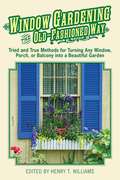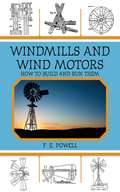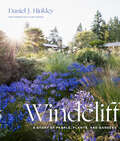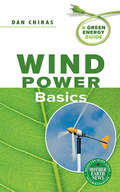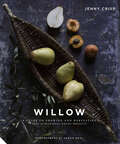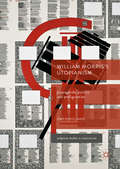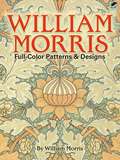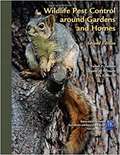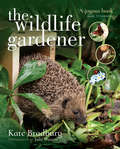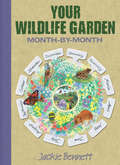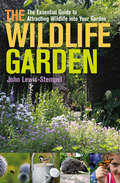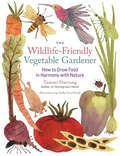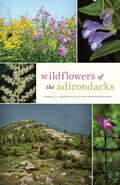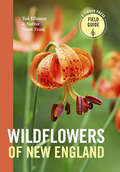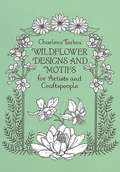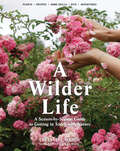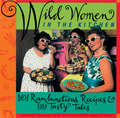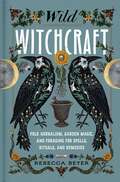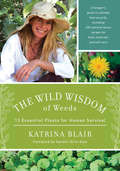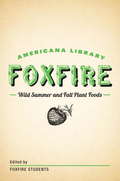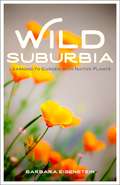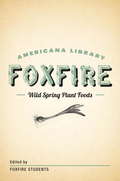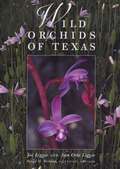- Table View
- List View
Window Gardening the Old-Fashioned Way: Tried and true methods for turning any window, porch,or balcony into a beautiful garden.
by Henry T. WilliamsThis vintage guide to interior decorating and gardening may have been at the height of fashion at the turn of the century, but many of its classic tips still hold true, and numerous styles and plants have come back into vogue. Learn about the very best flora and equipment to use when adding a green touch to any space, whether it's a cozy city apartment or a sprawling country villa. With over a hundred original hand-drawn illustrations and a charming, downto- earth style, Window Gardening the Old-Fashioned Way is a must-have guide for novice decorators and experts alike.
Windmills and Wind Motors: How to Build and Run Them
by F. E. PowellFree, clean, and sustainable energy: wind power is an essential resource everyone can harness. This comprehensive and compact historical work provides everything you need to learn about the theory and construction of everyday windmills, from small ones intended solely as models to those large enough to generate electricity. Powell provides all the necessities to get you on your way, including detailed, step-by-step instructions, illustrations, and designs for every part of the project.Types of windmill projects include:A model windmill with sails two feet acrossA working windmill with sails six feet across, suitable for pumping waterA practical windmill with sails ten feet across, capable of producing up to one-half horse power and able to run light machineryFor those interested in developing alternate, off-the-grid sources of energy, or even those who like to build for fun, Windmills and Wind Motors is a classic, useful guide to harnessing wind power.
Windcliff: A Story of People, Plants, and Gardens
by Daniel J. Hinkley&“Dan Hinkley is a rare man, generous, inspired, and gifted with an eye for beauty that is given to few people. How I long to wander again in the galloping beauty of his garden at Windcliff. Here it is, in all its inspiring wonder.&” —Anna Pavord, author of Landskipping and The Curious GardenerDaniel Hinkley is widely recognized as one of the foremost modern plant explorers and one of the world&’s leading plant collectors. He has created two outstanding private gardens—Heronswood and Windcliff. Both gardens, and the story of how one begat the other, are beautifully celebrated in Hinkley&’s new book, Windcliff.In these pages you will delight in Hinkley&’s recounting of the creation of his garden, the stories of the plants that fill its space, and in his sage gardening advice. Hinkley&’s spirited ruminations on the audacity and importance of garden-making—contemplations on the beauty of a sunflower turning its neck from dawn to dusk, the way a plant&’s scent can spur a memory, and much more—will appeal to the hearts of every gardener.Filled with Claire Takacs&’s otherworldly photography, Windcliff is spectacular for both its physical beauty and the quality of information it contains.
Wind Power Basics
by Dan ChirasWind energy is the fastest growing source of energy in the world, and by the year 2020 it is projected to supply at least 12 percent of global electrical demand.Wind Power Basics provides a clear understanding of wind and wind energy systems, including turbines, towers, inverters and batteries, site assessment, installation, and maintenance requirements.Whether you're considering your own small-scale wind energy system or just want a straightforward, detailed introduction to the benefits and challenges of this rapidly emerging technology, Wind Power Basics is the guide you need.Dan Chiras is a respected educator and an internationally acclaimed author who has published more than twenty-five books on residential renewable energy and green building, including Power From the Wind.
Willow: A Guide to Growing and Harvesting
by Jenny CrispLearn to grow, harvest & weave willow to make twenty simple projects—from napkin rings to laundry baskets—without the need of complicated tools.Handmade objects woven from natural materials are fast becoming the must-have accessories of the contemporary interior. Master basket maker and willow grower Jenny Crisp teaches you the key basket-weaving techniques and shows you how to make woven objects for the home and garden without the need of complicated tools.Jenny’s approach to her craft is innovative and moves forward beyond the old patterns and boundaries, to allow the reader to make work that is fresh and for contemporary use, and that will enhance the style of any interior.
William Morris’s Utopianism
by Owen HollandThis book offers a new interpretation of William Morris's utopianism as a strategic extension of his political writing. Morris's utopian writing, alongside his journalism and public lectures, constituted part of a sustained counter-hegemonic project that intervened both into the life-world of the fin de si#65533;cle socialist movement, as well as the dominant literary cultures of his day. Owen Holland demonstrates this by placing Morris in conversation with writers of first-wave feminism, nineteenth-century pastoralists, as well as the romance revivalists and imperialists of the 1880s. In doing so, he revises E. P. Thompson's and Miguel Abensour's argument that Morris's utopian writing should be conceived as anti-political and heuristic, concerned with the pedagogic education of desire, rather than with the more mundane work of propaganda. He shows how Morris's utopianism emerged against the grain of the now-here, embroiled in instrumental, propagandistic polemic, complicating Thompson's and Abensour's view of its anti-political character.
William Morris Full-Color Patterns and Designs
by William MorrisDefining beauty in art as the result of man's pleasure in his work, the noted English poet, designer, craftsman and pioneer Socialist William Morris (1834-1896) spent most of his life enthusiastically expounding this view through his many attractive designs for interior furnishings. The present book faithfully reproduces 40 of the most celebrated examples of Morris's work, reprinting in full color all the color plates from The Art of William Morris, published by George Bell & Sons in 1897. Included in this splendid, ready-to-use archive are richly detailed wallpaper designs incorporating marigold, vine, acanthus, apple, wild tulip, daisy and trellis motifs; hand-painted tiles with a rose pattern; chintzes displaying honeysuckle and bird and anemone designs; an acanthus design on printed velveteen; a superb peacock and dragon design on woven wool tapestry; a magnificent Kidderminster carpet with its lily motif. Originally intended to decorate Victorian homes, these tasteful patterns provide a wealth of source material for modern artists working in advertising, textile, residential or industrial design. Commercial artists and graphic designers will welcome this modestly priced collection of copyright-free designs by one of the most influential artists of the Victorian period.
Wildlife Pest Control around Gardens and Homes
by Terrell P. Salmon Desley A. Whisson Rex E. Marsh Robert E. LickliterWildlife Pest Control around Gardens and Homes by Terrell P. Salmon, Robert E. Lickliter
The Wildlife Gardener: Creating A Haven For Birds, Bees And Butterflies
by Kate Bradbury Julie WatsonCreate wildlife habitats and attract birds, bees, and other creatures to your very own garden: “A must-have for any gardening library.” —Gardeners World Filled with beautiful photos, this book is a practical guide for anyone who wants to make a home for wildlife in their garden—even if they don’t have a lot of space. Divided into sections on shelter, food, and water, it includes: *advice on the best nectar and pollen plants to grow *dos and don’ts of bird feeding *information on organic methods of pest control *ten projects—with step-by-step pictures—that will help encourage wildlife, such as creating a bumblebee nester, making a green roof, and building a hedgehog box Also included is a mini field guide, which will help you identify the birds and other creatures you’re likely to spot in your garden. The Wildlife Gardener gives tips on particular species, explaining what to look out for and how to cater for specific birds, mammals, bees, butterflies, moths, and pond life. “A joyous book.” —Alan Titchmarsh, author of My Secret Garden
Wildlife Garden month by month: Month-by-month (Month-by-Month)
by Jackie BennettThe Wildlife Garden; covers everything the gardener needs to know to cultivate and maintain a wildlife haven in their own garden, however small. There is a wealth of practical information and colour photographs on 'natural' gardening in a clear, easy-to-use, month-by-month format, allowing gardeners to find the advice they need instantly, when they need it. This title provides an introduction to the wild plants and creatures for each month, together with seasonal tips, tasks, checklists and detailed plant profiles. It offers easy-to-follow practical projects to create new habitats, such as making a wildlife pond, building a nest box, planning a herb bed, planting a summer meadow, and more.
The Wildlife Garden
by John Lewis-StempelWith the erosion of native wildlife habitats, gardens increasingly provide an invaluable source of food and shelter for Britain's fauna and flora. The Wildlife Garden is the essential guide to attracting birds to your bushes, butterflies to your buddleia and a whole array of other creatures into your garden - even if you only have a window box. Whether you just want to make an existing family space more wildlife friendly or go the whole hedgehog and turn your back garden into a mini nature reserve The Wildlife Garden will show you how to do it. There is full information on what plants are best for wildlife, on how to make refuges for insects and homes for bats, on making a pool for frogs, all whilst adding scent and colour to your surroundings.
The Wildlife Garden
by John Lewis-StempelWith the erosion of native wildlife habitats, gardens increasingly provide an invaluable source of food and shelter for Britain's fauna and flora. The Wildlife Garden is the essential guide to attracting birds to your bushes, butterflies to your buddleia and a whole array of other creatures into your garden - even if you only have a window box. Whether you just want to make an existing family space more wildlife friendly or go the whole hedgehog and turn your back garden into a mini nature reserve The Wildlife Garden will show you how to do it. There is full information on what plants are best for wildlife, on how to make refuges for insects and homes for bats, on making a pool for frogs, all whilst adding scent and colour to your surroundings.
The Wildlife-Friendly Vegetable Gardener: How to Grow Food in Harmony with Nature
by Tammi HartungPromoting a holistic ecological view, Tammi Hartung encourages you to invite wildlife into your garden. You’ll be amazed at how a variety of natural pollinators, pest predators, and soil enrichers can promote vibrant and healthy vegetables. Discover how a slug problem disappears once you’ve introduced a pond housing bullfrogs, how wasps can take care of tomato hornworms, and why skunks aren’t so bad after all. Learn how to garden with animals, rather than against them, and reap your most bountiful harvest yet.
Wildflowers of the Adirondacks
by Donald J. Leopold Lytton John MusselmanThe definitive field guide to the magnificent wildflowers of the Adirondacks.Covering more than six million acres of protected wilderness, the Adirondacks, with their landscape of high peaks, verdant wetlands, majestic trees, and lush carpets of flowers, is a pristine paradise for nature lovers. The only available identification guide to the Adirondack region's wildflowers, this comprehensive resource is packed with more than 300 gorgeous color images, one to represent almost every flower commonly found in this huge range. Revealing the stunning diversity of Adirondack wildflowers, from goldenrod and marsh blue violet to cattails and hellebore, the book includes • detailed botanical species accounts, arranged by flower color• images of each flower that highlight key features for easy ID• information about each species' natural history• descriptions of the region's upland, wetland, and aquatic habitats• a special section on the nearly 40 terrestrial orchid species found in the AdirondacksWritten by Donald J. Leopold and Lytton John Musselman, skilled botanists and the foremost authorities on these plants, this superior quality guide will appeal to residents of and visitors to the Adirondacks and northeastern mountains, including wildlife professionals, citizen scientists, backpackers, campers, photographers, bird watchers, artists, and wild food foragers.
Wildflowers of New England: Timber Press Field Guide (A Timber Press Field Guide)
by Ted Elliman New England Wild Flower SocietyWildflowers of New England is for hikers, naturalists, gardeners, and anyone wishing to learn more about the region’s diverse wildflowers, or just wanting to know the answer to "What’s that plant?" Ted Elliman, a plant ecologist for the New England Wild Flower Society, describes and illustrates more than 1,000 species commonly found in all six New England states, including annuals, perennials, and biennials, both native and naturalized. This helpful field guide uses a logical and convenient identification key based on flower color, petal arrangement, and leaf characteristics. One thousand color photographs help to confirm that you’ve got the right plant. The introduction includes an explanation of plant parts and information on plant names.
Wildflower Gardening
by James Underwood Crockett Oliver E. AllenThis gardening reference will teach you which wildflowers will grow best in your own backyard. Co-authored by James Underwood Crockett, an distinguished horticulturist, writer on gardening and, TV guru of plant care.
Wildflower Designs and Motifs for Artists and Craftspeople (Dover Pictorial Archive)
by Charlene TarboxClear, accurate illustrations of 163 common North American wildflowers -- tiger lily and water lily, snowdrop, ox-eye daisy, thistle, and wild strawberry among them. The flowers are depicted in full-page and half-page sizes in many different configurations: as individual blossoms, in borders, corners, clusters, wreaths, and garlands. Some are shown in frames.
A Wilder Life: A Season-by-Season Guide to Getting in Touch with Nature
by Celestine Maddy Abbye ChurchillIn our technology-driven, workaday world, connecting with nature has never before been more essential. <P><P>A Wilder Life, a beautiful oversized lifestyle book by the team behind the popular Wilder Quarterly, gives readers indispensable ideas for interacting with the great outdoors. Learn to plant a night-blooming garden, navigate by reading the stars, build an outdoor shelter, make dry shampoo, identify insects, cultivate butterflies in a backyard, or tint your clothes with natural dyes. <P>Like a modern-day Whole Earth Catalog, A Wilder Life gives us DIY projects and old-world skills that are being reclaimed by a new generation. <P>Divided into sections pertaining to each season and covering self-reliance, growing and gardening, cooking, health and beauty, and wilderness, and with photos and illustrations evocative of the great outdoors, A Wilder Life shows that getting in touch with nature is possible no matter who you are and—more important—where you are.
Wild Woman in the Kitchen: 101 Rambunctious Recipes & 99 Tasty Tales
by Nicole Alper Lynette RohrerMake room for the latest in the independent, iconoclastic, and utterly outrageous Wild Women series. Part cookbook, part history, part eye-opening entertainment, this lively compendium of little-known facts, recipes, and folklore includes 200 titillating tales and radical recipes from such wild women as Elizabeth Taylor, Alice B. Toklas, Sarah Bernhardt, and Lucille Ball. Photos & illustrations.
Wild Witchcraft: Folk Herbalism, Garden Magic, and Foraging for Spells, Rituals, and Remedies
by Rebecca BeyerLearn how to cultivate your own magical garden, begin your journey with folk herbalism, and awaken to your place in nature through practical skills from an experienced Appalachian forager and witch.Witchcraft is wild at heart, calling us into a relationship with the untamed world around us. Through the power of developing a relationship with plants, a witch—beginner or experienced—can practice their art more deeply and authentically by interacting with the beings that grow around us all. Bridging the gap between armchair witchcraft and the hedge witches of old, Wild Witchcraft empowers you to work directly with a wide variety of plants and trees safely and sustainably. With Wild Witchcraft, Rebecca Beyer draws from her years of experience as an Appalachian witch and forager to give you a practical guide to herbalism and natural magic that will share: -The history of witchcraft and Western herbalism -How to create and maintain your own herbal garden -Recipes for tinctures, teas, salves, and other potions to use in rites and rituals -Spells, remedies, and rituals created with the wild green world around you, covering a range of topics, from self-healing to love to celebrating the turning of the seasons -And much more! Wild Witchcraft welcomes us home to the natural world we all dwell in by exploring practical folk herbal and magical rites grounded in historical practices and a sustainable, green ethic.
The Wild Wisdom of Weeds
by Sandor Ellix Katz Katrina BlairThe Wild Wisdom of Weeds is the only book on foraging and edible weeds to focus on the thirteen weeds found all over the world, each of which represents a complete food source and extensive medical pharmacy and first-aid kit. More than just a field guide to wild edibles, it is a global plan for human survival. When Katrina Blair was eleven she had a life-changing experience where wild plants spoke to her, beckoning her to become a champion of their cause. Since then she has spent months on end taking walkabouts in the wild, eating nothing but what she forages, and has become a wild-foods advocate, community activist, gardener, and chef, teaching and presenting internationally about foraging and the healthful lifestyle it promotes. Katrina Blair's philosophy in The Wild Wisdom of Weeds is sobering, realistic, and ultimately optimistic. If we can open our eyes to see the wisdom found in these weeds right under our noses, instead of trying to eradicate an "invasive," we will achieve true food security. The Wild Wisdom of Weeds is about healing ourselves both in body and in spirit, in an age where technology, commodity agriculture, and processed foods dictate the terms of our intelligence. But if we can become familiar with these thirteen edible survival weeds found all over the world, we will never go hungry, and we will become closer to our own wild human instincts--all the while enjoying the freshest, wildest, and most nutritious food there is. For free!The thirteen plants found growing in every region across the world are: dandelion, mallow, purslane, plantain, thistle, amaranth, dock, mustard, grass, chickweed, clover, lambsquarter, and knotweed. These special plants contribute to the regeneration of the earth while supporting the survival of our human species; they grow everywhere where human civilization exists, from the hottest deserts to the Arctic Circle, following the path of human disturbance. Indeed, the more humans disturb the earth and put our food supply at risk, the more these thirteen plants proliferate. It's a survival plan for the ages.Including over one hundred unique recipes, Katrina Blair's book teaches us how to prepare these wild plants from root to seed in soups, salads, slaws, crackers, pestos, seed breads, and seed butters; cereals, green powders, sauerkrauts, smoothies, and milks; first-aid concoctions such as tinctures, teas, salves, and soothers; self-care/beauty products including shampoo, mouthwash, toothpaste (and brush), face masks; and a lot more. Whether readers are based at home or traveling, this book aims to empower individuals to maintain a state of optimal health with minimal cost and effort.
Wild Summer and Fall Plant Foods: The Foxfire Americana Library (8) (The Foxfire Americana Library)
by Inc. Foxfire FundA handy illustrated guide to the edible plant life available in Appalachia and surrounding areas during the summer and fall seasons. From berries to herbs perfect for teas and tonics, each entry includes information on where to find the plant, how to spot it, and the best ways to eat it, often with recipes. Plants include: GooseberriesRaspberriesBlueberriesFigsPawpawsCattailsNutgrassThistleCatnipSpearmintPeppermintBlue-mountain teaYarrowChamomile DillsBlack WalnutsPecansHazelnuts
Wild Suburbia: Learning to Garden with Native Plants
by Barbara EisensteinWild Suburbia guides us through the process of transforming a traditional, high water-use yard into a peaceful habitat garden abounding with native plants. Author Barbara Eisenstein emphasizes that gardening is a rewarding activity rather than a finished product, from removing lawns and getting in touch with a yard's climate to choosing plants and helping them thrive. Supplementing her advice with personal stories from her decades of experience working with native plants, Eisenstein illuminates the joys of tending a native garden-and assures us that any challenges, from managing pests to disapproving neighbors, should never sap the enjoyment out of a pleasurable and fulfilling hobby. For plant lovers curious about their own ecosystems, Wild Suburbia offers a style of gardening that nurtures biodiversity, deepens connection to place, and encourages new and seasoned gardeners alike to experiment and have fun.
Wild Spring Plant Foods: The Foxfire AMericana Library (7) (The Foxfire Americana Library)
by Inc. Foxfire FundA handy illustrated guide to the edible plant life available in Appalachia and other temperate areas during the spring. From sassafras to rhubarb, each entry includes instructions on where to find the plant, how to spot it, and the ways it is best eaten, often with recipes. Plants include: MorelAsparagusWild onionWild garlic NettlesWild radishWhite mustardWater cressHorseradishChicoryWild lettuceDandelion
Wild Orchids of Texas
by Joe Liggio Ann Orto LiggioFrom the East Texas swamps and forests to the Edwards Plateau canyons and the Trans-Pecos mountains, Texas hosts a surprising number of native orchids. Their exquisite beauty endears them to everyone from wildflower lovers to professional botanists and conservationists. This beautifully illustrated book presents all 54 wild orchids of Texas. The species descriptions that accompany Joe Liggio's lovely color photos discuss the plant's flowers, blooming season, pollinators, typical habitats, and range (also shown by map), including its distribution within and beyond Texas. The species are grouped by genus and also listed by color, county, and habitat for easy reference. In addition to the species accounts, the authors offer a general natural history of Texas orchids that discusses such topics as pollination and reproduction, special growing requirements, and threats to orchids from loss of habitats and careless collecting. They also describe the many orchid habitats in Texas and the species that grow in each. This wide variety of information, which has never before been collected in one volume for a general readership, makes this book the essential guide to Texas' wild orchids.
